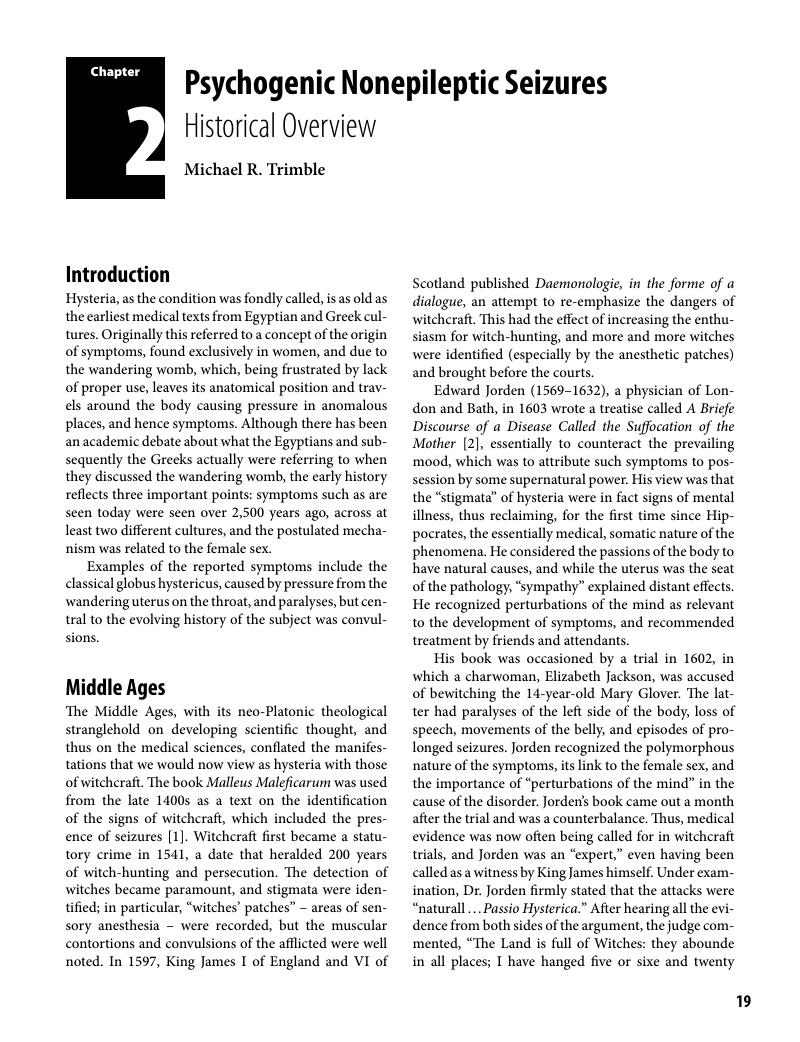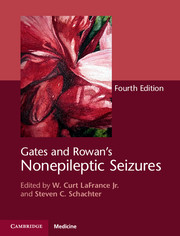Book contents
- Gates and Rowan's
- Gates and Rowan's Nonepileptic Seizures
- Copyright page
- Contents
- Contributors
- Preface
- Acknowledgements
- Video EEGs and Video Clips
- Dedication for Dr. A. James Rowan
- Dedication for Dr. John R. Gates
- In Remembrance of Dr. A. James Rowan
- In Remembrance of Dr. John R. Gates
- Section 1 Recognition, Diagnosis, and Impact of Nonepileptic Seizures
- Chapter 1 Epidemiology and Classification of Nonepileptic Seizures
- Chapter 2 Psychogenic Nonepileptic Seizures
- Chapter 3 The Costs and Burdens of Psychogenic Nonepileptic Seizures in Context
- Chapter 4 Clinical Features and the Role of Video-EEG Monitoring
- Chapter 5 Comorbidity of Epileptic and Psychogenic Nonepileptic Seizures
- Chapter 6 Nonepileptic Paroxysmal Neurological and Cardiac Events
- Chapter 7 Parasomnias
- Chapter 8 Hypnosis for Psychogenic Nonepileptic Seizures and Psychogenic Movement Disorders
- Chapter 9 Using Linguistic Analysis to Discriminate Between Patients with Psychogenic Nonepileptic Seizures and Patients with Epilepsy
- Chapter 10 Diagnosis of Nonepileptic Seizures in Children
- Chapter 11 Diagnosis of Nonepileptic Seizures in the Elderly
- Section 2 Nonepileptic Seizures: Culture, Cognition, and Personality Clusters
- Section 3 Psychiatric and Neuropsychological Considerations in Children and Adolescents with Psychogenic Nonepileptic Seizures
- Section 4 Psychiatric and Neuropsychological Considerations in Adults with Psychogenic Nonepileptic Seizures
- Section 5 Treatment Considerations for Psychogenic Nonepileptic Seizures
- Appendix: Care Coordination Treatment Plans for Patients with Psychogenic Nonepileptic Seizures (PNES)
- Index
- References
Chapter 2 - Psychogenic Nonepileptic Seizures
Historical Overview
from Section 1 - Recognition, Diagnosis, and Impact of Nonepileptic Seizures
Published online by Cambridge University Press: 18 May 2018
- Gates and Rowan's
- Gates and Rowan's Nonepileptic Seizures
- Copyright page
- Contents
- Contributors
- Preface
- Acknowledgements
- Video EEGs and Video Clips
- Dedication for Dr. A. James Rowan
- Dedication for Dr. John R. Gates
- In Remembrance of Dr. A. James Rowan
- In Remembrance of Dr. John R. Gates
- Section 1 Recognition, Diagnosis, and Impact of Nonepileptic Seizures
- Chapter 1 Epidemiology and Classification of Nonepileptic Seizures
- Chapter 2 Psychogenic Nonepileptic Seizures
- Chapter 3 The Costs and Burdens of Psychogenic Nonepileptic Seizures in Context
- Chapter 4 Clinical Features and the Role of Video-EEG Monitoring
- Chapter 5 Comorbidity of Epileptic and Psychogenic Nonepileptic Seizures
- Chapter 6 Nonepileptic Paroxysmal Neurological and Cardiac Events
- Chapter 7 Parasomnias
- Chapter 8 Hypnosis for Psychogenic Nonepileptic Seizures and Psychogenic Movement Disorders
- Chapter 9 Using Linguistic Analysis to Discriminate Between Patients with Psychogenic Nonepileptic Seizures and Patients with Epilepsy
- Chapter 10 Diagnosis of Nonepileptic Seizures in Children
- Chapter 11 Diagnosis of Nonepileptic Seizures in the Elderly
- Section 2 Nonepileptic Seizures: Culture, Cognition, and Personality Clusters
- Section 3 Psychiatric and Neuropsychological Considerations in Children and Adolescents with Psychogenic Nonepileptic Seizures
- Section 4 Psychiatric and Neuropsychological Considerations in Adults with Psychogenic Nonepileptic Seizures
- Section 5 Treatment Considerations for Psychogenic Nonepileptic Seizures
- Appendix: Care Coordination Treatment Plans for Patients with Psychogenic Nonepileptic Seizures (PNES)
- Index
- References
Summary

- Type
- Chapter
- Information
- Gates and Rowan's Nonepileptic Seizures , pp. 19 - 30Publisher: Cambridge University PressPrint publication year: 2018

